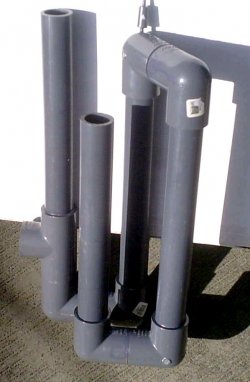For the overflow, don't use an overflow box, use hole, drilled into the glass at the back. It's the only consistantly reliable way to go

All overflow boxes that I'm aware of on the market break their syphon when the flow through them stops, so when flow is turned on again they don't start removing water from the display and you end up with a wet floor and empty sump. Pumps at both are hard to ballence and a blockage will lead to a wet floor and/or a burnt out pump due to running one or both pumps dry.
For the trickle plate, I'd use Acrylic or Perspex
For the filter itself, your going to need a bigger tank. The minimum size for a sump is 25% of the display, or 12.5G in your case. With a 10G, the return pump will spend a lot of time running dry, leading to pramature failures of most of it's working parts. Top up the sump to stop this, and water will go everywere if the power fails, as the water will come back down from the display and pipes back to the over-full sump...
Idealy, for a wet-dry filter, the tank will be taller than long/wide. This allows for a media stack.

Have once divider at the bottom, covering the retrun pump and heater(s) to stop them clogging/chewing/melting the filter material, put your biological media on top of that, then the other filter plate, then a selection of sponges and floss, going from course to fine in that order top-to-bottom. Fill the display to a point where water starts to overflow into the sump and stop there. Give it half an hour then brim the sump before turning on the return pump. Again, leave it for half an hour, then come back and mark a max-fill line on the sump. Fill above that line and the floor get's wet in a power outage. Fill to or below the line and the system is safe

All the best
Rabbut

 All overflow boxes that I'm aware of on the market break their syphon when the flow through them stops, so when flow is turned on again they don't start removing water from the display and you end up with a wet floor and empty sump. Pumps at both are hard to ballence and a blockage will lead to a wet floor and/or a burnt out pump due to running one or both pumps dry.
All overflow boxes that I'm aware of on the market break their syphon when the flow through them stops, so when flow is turned on again they don't start removing water from the display and you end up with a wet floor and empty sump. Pumps at both are hard to ballence and a blockage will lead to a wet floor and/or a burnt out pump due to running one or both pumps dry. Have once divider at the bottom, covering the retrun pump and heater(s) to stop them clogging/chewing/melting the filter material, put your biological media on top of that, then the other filter plate, then a selection of sponges and floss, going from course to fine in that order top-to-bottom. Fill the display to a point where water starts to overflow into the sump and stop there. Give it half an hour then brim the sump before turning on the return pump. Again, leave it for half an hour, then come back and mark a max-fill line on the sump. Fill above that line and the floor get's wet in a power outage. Fill to or below the line and the system is safe
Have once divider at the bottom, covering the retrun pump and heater(s) to stop them clogging/chewing/melting the filter material, put your biological media on top of that, then the other filter plate, then a selection of sponges and floss, going from course to fine in that order top-to-bottom. Fill the display to a point where water starts to overflow into the sump and stop there. Give it half an hour then brim the sump before turning on the return pump. Again, leave it for half an hour, then come back and mark a max-fill line on the sump. Fill above that line and the floor get's wet in a power outage. Fill to or below the line and the system is safe  /www.3reef.com/forums/i-made/nice-ch...flow-29396.html
/www.3reef.com/forums/i-made/nice-ch...flow-29396.html

